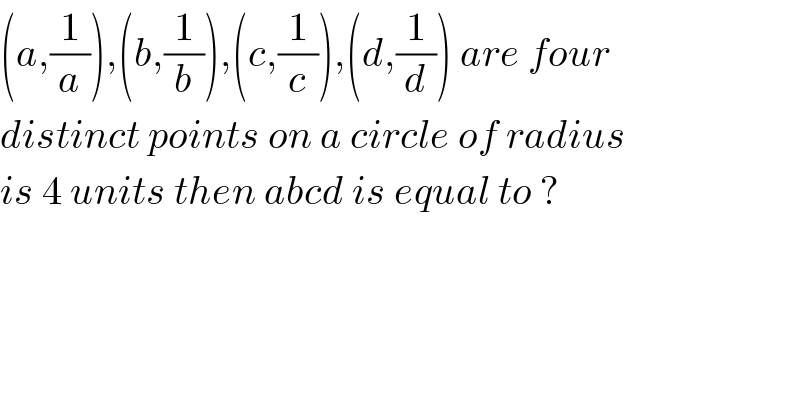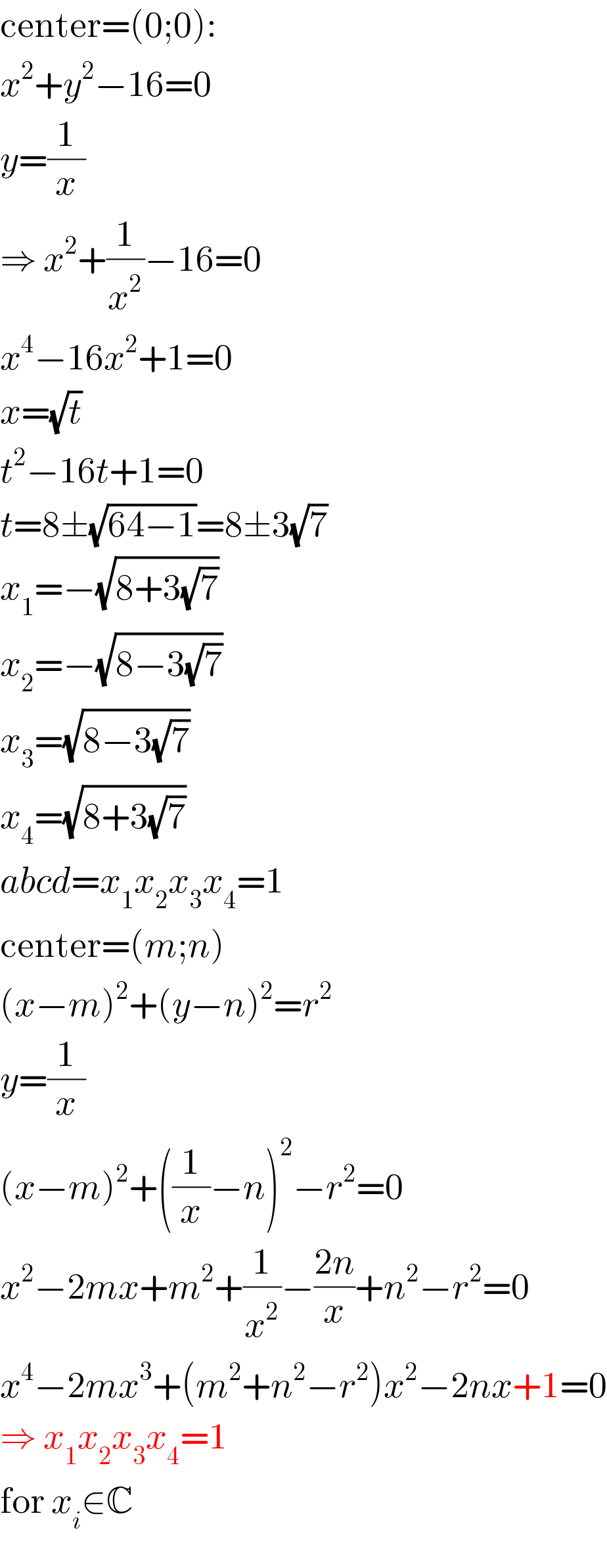Question Number 31569 by momo last updated on 10/Mar/18

$$\left({a},\frac{\mathrm{1}}{{a}}\right),\left({b},\frac{\mathrm{1}}{{b}}\right),\left({c},\frac{\mathrm{1}}{{c}}\right),\left({d},\frac{\mathrm{1}}{{d}}\right)\:{are}\:{four} \\ $$$${distinct}\:{points}\:{on}\:{a}\:{circle}\:{of}\:{radius} \\ $$$${is}\:\mathrm{4}\:{units}\:{then}\:{abcd}\:{is}\:{equal}\:{to}\:? \\ $$
Answered by MJS last updated on 10/Mar/18

$$\mathrm{center}=\left(\mathrm{0};\mathrm{0}\right): \\ $$$${x}^{\mathrm{2}} +{y}^{\mathrm{2}} −\mathrm{16}=\mathrm{0} \\ $$$${y}=\frac{\mathrm{1}}{{x}} \\ $$$$\Rightarrow\:{x}^{\mathrm{2}} +\frac{\mathrm{1}}{{x}^{\mathrm{2}} }−\mathrm{16}=\mathrm{0} \\ $$$${x}^{\mathrm{4}} −\mathrm{16}{x}^{\mathrm{2}} +\mathrm{1}=\mathrm{0} \\ $$$${x}=\sqrt{{t}} \\ $$$${t}^{\mathrm{2}} −\mathrm{16}{t}+\mathrm{1}=\mathrm{0} \\ $$$${t}=\mathrm{8}\pm\sqrt{\mathrm{64}−\mathrm{1}}=\mathrm{8}\pm\mathrm{3}\sqrt{\mathrm{7}} \\ $$$${x}_{\mathrm{1}} =−\sqrt{\mathrm{8}+\mathrm{3}\sqrt{\mathrm{7}}} \\ $$$${x}_{\mathrm{2}} =−\sqrt{\mathrm{8}−\mathrm{3}\sqrt{\mathrm{7}}} \\ $$$${x}_{\mathrm{3}} =\sqrt{\mathrm{8}−\mathrm{3}\sqrt{\mathrm{7}}} \\ $$$${x}_{\mathrm{4}} =\sqrt{\mathrm{8}+\mathrm{3}\sqrt{\mathrm{7}}} \\ $$$${abcd}={x}_{\mathrm{1}} {x}_{\mathrm{2}} {x}_{\mathrm{3}} {x}_{\mathrm{4}} =\mathrm{1} \\ $$$$\mathrm{center}=\left({m};{n}\right) \\ $$$$\left({x}−{m}\right)^{\mathrm{2}} +\left({y}−{n}\right)^{\mathrm{2}} ={r}^{\mathrm{2}} \\ $$$${y}=\frac{\mathrm{1}}{{x}} \\ $$$$\left({x}−{m}\right)^{\mathrm{2}} +\left(\frac{\mathrm{1}}{{x}}−{n}\right)^{\mathrm{2}} −{r}^{\mathrm{2}} =\mathrm{0} \\ $$$${x}^{\mathrm{2}} −\mathrm{2}{mx}+{m}^{\mathrm{2}} +\frac{\mathrm{1}}{{x}^{\mathrm{2}} }−\frac{\mathrm{2}{n}}{{x}}+{n}^{\mathrm{2}} −{r}^{\mathrm{2}} =\mathrm{0} \\ $$$${x}^{\mathrm{4}} −\mathrm{2}{mx}^{\mathrm{3}} +\left({m}^{\mathrm{2}} +{n}^{\mathrm{2}} −{r}^{\mathrm{2}} \right){x}^{\mathrm{2}} −\mathrm{2}{nx}+\mathrm{1}=\mathrm{0} \\ $$$$\Rightarrow\:{x}_{\mathrm{1}} {x}_{\mathrm{2}} {x}_{\mathrm{3}} {x}_{\mathrm{4}} =\mathrm{1} \\ $$$$\mathrm{for}\:{x}_{{i}} \in\mathbb{C} \\ $$
